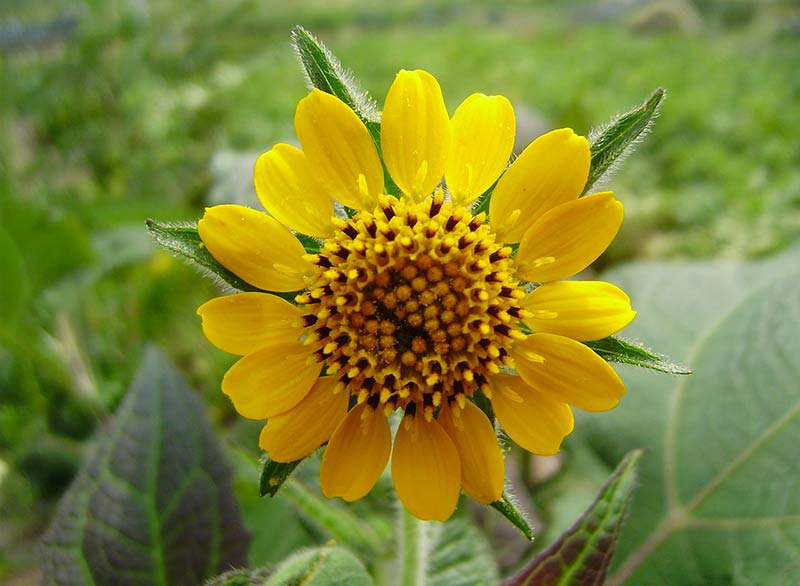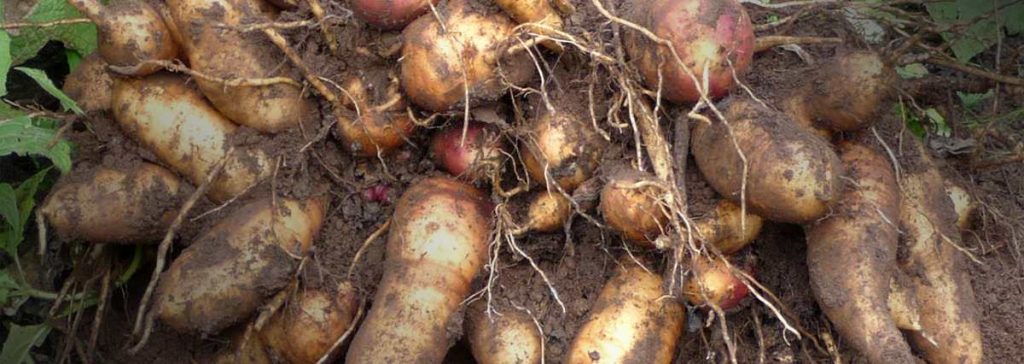Sweet Carrot – Smallanthus Sonchfolius – Yacon
Like the Stevia Rebaudiana, also the sweet carrot, the smallanthus donchifolius will be a plant
We will hear a lot about in the future. From its antique origins, ( references to the Sweet Carrot have been found from as far back as 2000BC), but it is not certain of its geographical origins and providence which is identified along the Cordilliera of the Andes, of Argentina and Chile, Bolivia and Peru. A few decades before the end of the last century, the Sweet Carrot was imported into the USA, Japan and in area further East of the Asiatic continent, more for its health properties which for their organoleptic and gastronomic. In their original zone instead, at the same time the cultivation diminished to the point of almost disappearing as a commercial product and was more cultivated in domestic vegetable gardens.
The cultivational zone including the sea level in New Zealand AT ALMOST 3000 metres from the mountain chain of the Andes.
Belonging to theAsteraceae family, the same as the Stevia Rebaudiana, of the sunflower, margherita, etc. it is a plant which we can compare to our common dahlia. , during the cold winter, the top aerial part dies and that which is underground holds up in temperatures a few degrees below zero. In more rigid temperatures , it is possible to dig it up and conserve it in a not too humid place until the following Spring.
It can reach heights of up to one and a half metres with herbaceous trunks which will break easily with strong weather;; it has large light green leaves with a little but evident veining visible on the page above with the characteristic of having a long stalk surrounding the narrow part of the limb, the leaves grow diametrically opposed and turned to 90° for every root system. It is composed of two types of root. The propagating root and the storage root.
The propagation roots are relatively dense and very delicate. The shoots begin its future development pf the aerial part, while the storage roots reserve the nutrients for the plant and represent the edible part , the Sweet Carrot.
TERRAIN
The Sweet Carrot (Smallanthus Sonchifolius) grows well in volcanic soil from the cordilliera andina and in coastal salty soil from the shores of New Zealand. It doesn’t have specific problems of chemical characteristics of soil, even if the ph is ideal e that is neutral, supports jumps from acid to calico soil. The soil should be well worked and soft, which holds humidity, but not stagnant water which could rot the roots.

FLORA AND FRUITS
As with our common dahlia, the Sweet Carrot, during the course of Summer, at the peak grows a single trunk in the form of what we commonly and inappropriately call The Yellow Flower. Of a diameter of 15/20 CM, practically the same as the sunflower, it is formed of a central part called calatide or sunburst where many little flowers which are okra yellow ; all around the sunburst with a spoke system which is very distinct, the petals are shiny yellow. These are false petals and have the function of attracting insects to fertilize the real flowers and real petals.
Once fertilized, the real flowers give the development to that which is the sunflower, we call these seeds, but they are in reality the fruit. These small fruit are of no organoleptic interest, but are needed as a food for small animals and small flying animals also sheep and goats, typical of the original Sweet Carrot’s origins.
USE AND HEALTH GIVING PROPERTIES
The parts used are the storage roots and the leaves
When a the storage roots, that is the tubers, have reached their maximum dimensions the beginning of Autumn, you dig up the plant with care, you cut the herbaceous trunks and thereby lift the tubers, and if the climate permits, there you replant wherever you have to shelter it. for the following spring. In this operation you need to pay attention to not break the delicate propagation roots, vital to the future of the plant. The tubers collected, have a delicate brownish peel, with an unpleasant taste similar to solvent. They are ready to use, but if left in the sun or to the air for a few days until they begin to wrinkle acquiring organoleptic qualities which are decidedly superior. The starch, in fact, contained in the tuber, once removed from the plant, it transforms into sugar, this process is notably accelerated under the rays of the sun. pay attention: do not confuse the sugars with the sucrose which we use to sweeten our food!
The sugars are a series of assembled organics made up of diverse elements indispensable to the human body. have a crispy consistency and are sweet fresh and thirst quenching, you recall a taste of pear melon and / or watermelon, at the second grade of transformation of the starches and can be eaten as they are, or used as any sweet fruit, type of pear, apple, banana, in fruit salad, blended and anything else is possible. In its country of origin apart from eating the fruit, it is used in the preparation of salads, and as our potato, as a side dish to meat and fish. We understand however the strong gastronomic differences between these countries and ours.
In all of South America the tradition from thousands of years ago is used to prepare a herbal tea using the dried leaves . this is called Andino Tea, it is commonly used in Japan where the Ministry of Health supports the consumption because of the benefits it brings to the human body.
The Sweet Carrot is considered a pharmafood.
As with the Stevia Rebaudiana, also the Sweet Carrot is very important in the diabetics diet. If the Stevia Rebaudiana can be used as an alternative sucrose in various sweetners and to sweeten food. The Sweet Carrot when used as a pharmafood, contributes to normalizing the diabetics life.
Widely speaking and in simple words, Diabetes is a dysfunction of the pancreas in that it does not produce or doesn’t produce sufficient insulin. Insulin is a substance(polysaccharide), which assists the glucose, that our organism obtains from the sugars in the our food, to pass into the blood through the cells and tissues, where it serves as a source of energy. Without insulin the glucose isn’t used and stays in the blood causing hyperglycemia, which unusually we call, even if inappropriately, diabetes with all the pathologies associated with it. The Sweet Carrot contains diverse substances which eliminate excess glucose from the blood thus impeding the complications of hyperglycemia, such as frequent subcutaneous insulin injections. This substance is present in the storage roots which instill with the leaves. In Japan scientists have been specifically working for decades on this food, and have already commercialized a product destined for diabetics and derived from the Sweet Carrot.
Among the various substances contained in the Sweet Carrot, there is one which is very specific: inulina.
Inulina is a sugar which we find in plants belonging to theAsteraceae family in general and in high quantities in the Smallanthus Sonchifolius – Sweet Carrot which is part of the family. While insulin, as we have mentioned, is a hormone product from the cells of the pancreas.
Inulina, apart from normalizing the glucose in the blood, has an important function as a regulator of the intestine and is a sugar which is no absorbed, and so is ideal even in a hyper-calorific diet; it reduces the build up of fat in the blood, hyper-lipidemia, like cholesterol and triglycerides, is also indicated for the cure and containment of obesity.
Apart from these characteristics the Sweet Carrot per 100 grams of product has a modest contribution of (54k/cal) a lot of potassium with Carbohydrates 14%, antociani 200mg, vitamin C 5mg, polifenol, composites almost similar to those of antociani 200mg.
A curiosity: the content of polifenol in 100 grams of Sweet Carrot has the same anti-oxidising effect as a good glass of wine, without having the same side effects.
POTTING PRUNING AND CULTIVATION
Looking at the typology of the plant potting is not necessary. During the course of Summer you can pick the leaves to make herbal teas whilst the herbaceous trunk should be cut down to zero with the approaching cold season. Plant in fresh, rich and soft soil, we don’t have to pay any attention, in the case of sufferance instead it is advised the usual mulch of mature manure or ternary fertilizer with microelements.
Having quite high herbaceous trunks it is opportune to support the plant to avoid breakage in the case of bad weather, just as you would for the dahlia.
Herbaceous trunks and large soft leaves are characteristics which lead us to pay specific attention to watering: on hot sunny days excessive evaporation could bring about a dangerous shortage of water. Stagnant water or excessive watering or specific climatic conditions could because the formation of rot. (Botrytis Cinerea, grey mould) on the flowers and tender shoots like the root apparatus. If this happens you should remove the stricken area rather than use a fungicide for the aerial parts; for the root system, when you become aware of the attack, you should dig up the plant and cut back hard on the aerial apparatus and eliminate the , are leafminer larva and moth larva which gnaw the leaves are the most annoying parasites: if manual elimination becomes difficult you will need to use and insecticide taking care to respect the timing of the deficiency in the case of picking the leaves. The deficiency timing is the interval of time between the plant health treatment and the metabolism of the parts of the plant main properties of the product used.
It is rare that the larva attacks the root system in that the rizoderma and the periderma. The most external part of the root which as we said before is distinguished by its unpleasant taste of solvent.
About ten years ago ‘The Piedmont Region’ through the non profit organization Slowfood, financed a project Presidioalimentare with the aim of relaunching the production in the countries of origin and the spread of awareness of the Smallanthus Sonchifolius – Sweet Carrot still unknown.
Up until today there are no results of this project, but PRANDINI’S GARDEN NURSERY CENTRE hopes to be able to contribute to the disclosure and, why not? To help the Andine population indirectly.

